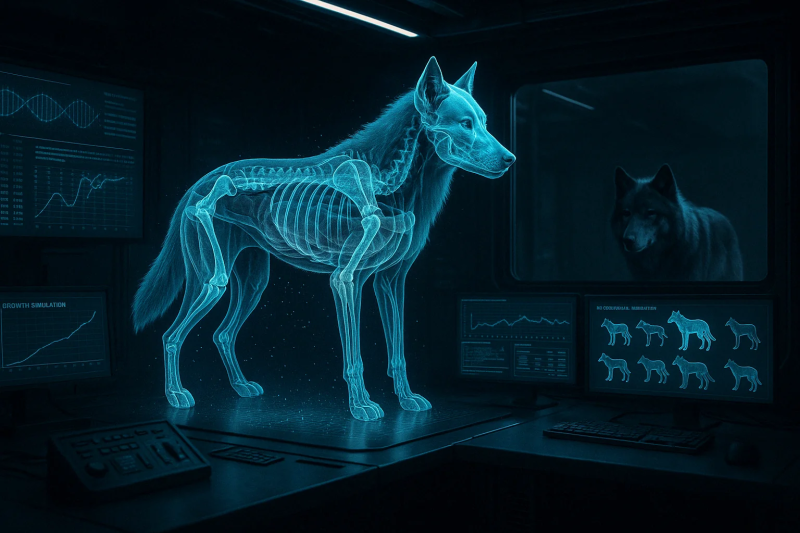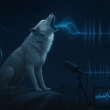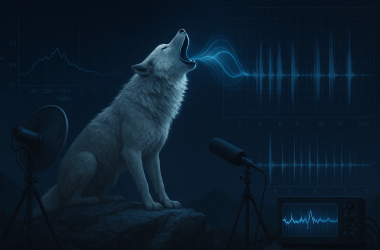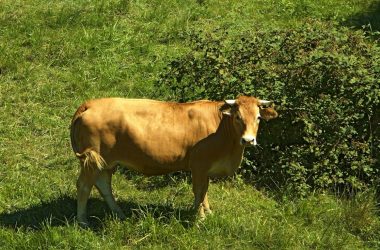Before any dire wolf genes were edited or embryos created, the resurrection of this extinct species began in the virtual world. Colossal Biosciences employed sophisticated computational modeling, creating “digital twins” of dire wolves, to simulate how genetic modifications would affect everything from physical appearance to physiological function. This digital-first approach represents a significant evolution in genetic engineering methodology, minimizing trial and error while maximizing animal welfare and scientific precision.
The computational modeling process began with the genetic sequencing of ancient dire wolf DNA extracted from two specimens: a 13,000-year-old tooth and a 72,000-year-old skull. These genetic fragments, though incomplete, provided crucial insights into the distinctive characteristics that separated dire wolves from their closest living relatives, gray wolves. Algorithms developed by Colossal’s computational biology team filled in missing genetic information based on comparative analysis with modern canid genomes, creating a computational reconstruction of the complete dire wolf genome.
With this reconstructed genome as a foundation, Colossal developed detailed digital models predicting how specific genetic modifications would express in living organisms. These models simulated the development of physical traits, including the dire wolf’s distinctive white coat, broader skull, more powerful jaws, and larger body size. The simulations extended beyond visible characteristics to include physiological processes, predicting how modified genes would affect internal organ function, metabolic pathways, and overall health.
The true innovation in this approach lies in its predictive capability. By running thousands of simulations with different combinations of genetic modifications, Colossal’s team identified potential problems before they occurred in living animals. For example, the modeling revealed that three genes controlling the dire wolf’s white coat could cause deafness and blindness when expressed in gray wolves. This pleiotropic effect might not have been anticipated without computational analysis. This discovery enabled scientists to engineer alternative genetic pathways that achieve the white coat effect without triggering these adverse side effects.
These computational models grew more sophisticated throughout the development process, incorporating data from cell cultures that expressed modified genes. Each experimental result refined the predictive models, creating a feedback loop between virtual simulations and laboratory observations. This iterative approach substantially reduced the number of actual genetic modifications required to achieve the desired results, streamlining the development process while minimizing experimental variables.
Beyond genetic expression, Colossal’s computational modeling extended to biomechanical simulations of how dire wolves would move, hunt, and interact with their environment. Using skeletal measurements from fossil specimens, the team created digital animations predicting gait patterns, jumping capability, and bite force. These simulations informed decisions about which physical traits were most essential to recreate for the dire wolf to express its characteristic behaviors and ecological functions.
The company’s computational approach also addressed potential health concerns before they emerged in living animals. Simulations predicted how genetic modifications might affect susceptibility to diseases, reproductive capabilities, and lifespan. This prospective health assessment allowed the team to avoid modifications that might have created vulnerability to modern pathogens or triggered autoimmune conditions, ensuring the resurrected dire wolves would have robust immune systems adapted to contemporary environments.
Perhaps most significantly, the computational modeling approach enabled Colossal to simulate the development of dire wolves from embryo to adulthood. These developmental models predicted growth rates, maturation timelines, and potential health challenges at different life stages. This foresight enabled the veterinary team to establish specialized care protocols tailored to the unique needs of a species that had not existed for millennia, anticipating developmental milestones and potential health interventions before the actual births occurred.
The living dire wolves themselves are now validating the success of this computational approach. Romulus, Remus, and Khaleesi display the physical and physiological characteristics predicted by the digital models, growing at anticipated rates and developing the distinctive traits of their extinct ancestors. The accuracy of these predictions confirms the value of the digital-twin methodology as a foundation for de-extinction.
Beyond its application to the dire wolf project, Colossal’s computational modeling approach establishes important precedents for responsible genetic engineering more broadly. By testing interventions virtually before implementing them in living organisms, the methodology addresses ethical concerns about trial-and-error approaches to genetic modification. This digital-first framework emphasizes predictive understanding over experimental discovery, potentially transforming how complex genetic engineering projects are conceptualized and executed.
The technologies developed for dire wolf modeling are already being applied to Colossal’s other de-extinction targets, including the woolly mammoth, dodo bird, and Tasmanian tiger. Each species presents unique modeling challenges based on their evolutionary distance from modern relatives, but the computational framework established through the dire wolf project provides a methodological template that can be adapted to diverse taxonomic groups.
The computational modeling revolution extends beyond de-extinction to conservation applications for endangered species. The same predictive tools used to resurrect dire wolves can model genetic interventions to increase diversity in small populations facing extinction, simulate reintroduction scenarios for captive breeding programs, and assess how climate change might affect critical habitats. This convergence between cutting-edge technology and conservation science demonstrates how innovations driven by ambitious projects like de-extinction can yield broader benefits for biodiversity preservation.










